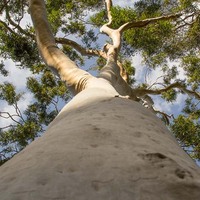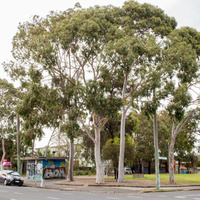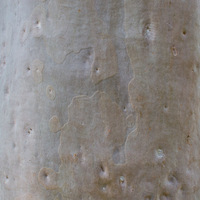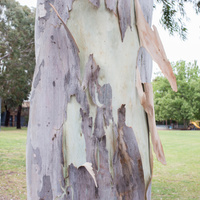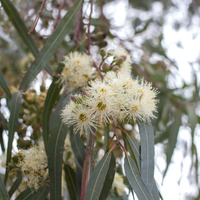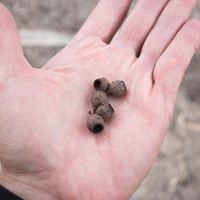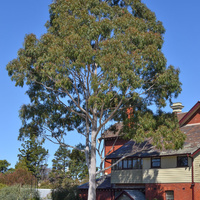Common name: Lemon Eucalyptus
Other common names: Citron Scented Gum, Lemon Scented Gum, Spotted Gum
Description
A native of eastern Australia, the Lemon Eucalyptus tree yields valuable essential oil, wood and nectar for honey production.
There are two subspecies recognised, Corymbia citriodora subsp. variegata, with a natural range limited to the subtropics and Corymbia citriodora subsp. citriodora, with a more expansive range that extends from the subtropics to the hilly tropics.
It is fast-growing and may become a large tree, attaining heights up to 50 m (165 ft) in natural woodland and forest habitats, though it is typically 20 to 30 m (65 to 100 ft) tall.
The trunk is usually straight, slender, and mostly branch-free, with flaking bark exposing smooth, creamy-white underbark that, with weathering, becomes pinkish, bronze or grey. The branches are few and ascending, forming an open, rounded, moderately leafy crown.
The leaves are typical of an oil-yielding Eucalyptus, being dull green with a narrow blade shape and those of subsp. citriodora are strongly lemon fragrant when crushed.
From winter to spring, small powder-puff-shaped flowers with long white stamens come into bloom. They are followed by small, woody, urn-shaped seed capsules containing tiny, glossy, reddish-black seed.
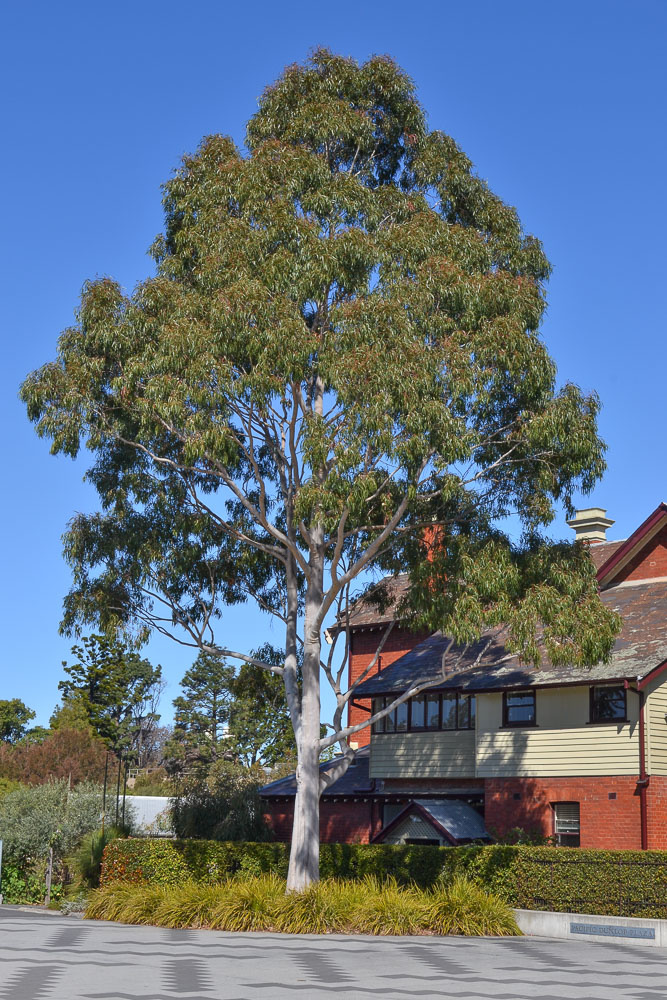
Melbourne, Australia
Use
The leaves of subsp. citriodora yield commercial quantities of a lemon-scented essential oil extracted by steam distillation. The oil is used mainly as a fragrance, in perfume and toiletry products, and as raw material for menthol production. A high citronellal content also gives it natural insect-repellent properties, which has led to the development of compounds such as 'Citriodiol', the active ingredient found in many insect-repellent sprays and lotions sold in the market today.
About 10,000 to 25,000 kilograms of fresh leaves can be harvested per hectare per year in commercial plantations and, with an average oil content of 1%, yield 100 to 250 kilograms of oil, the equivalent of 90 to 220 pounds of oil per acre.
Both subspecies produce a heavy wood in the 800 to 1000 kg per cubic meter (50 to 62 lb per cubic ft) range, with high natural resistance to rot, decay and wood-boring insects. This classes it as a durable hardwood suitable for indoor and outdoor construction. The sapwood is whitish, and the heartwood light to dark red-brown with attractive, wavy figuring.
Well-formed logs are sawn into beams and planks used in heavy and light construction, house frames, and interior and exterior flooring or decking. Smaller diameter roundwood is harvested for transmission poles, fence posts, high-impact tool handles, and fuelwood, either for firewood or charcoal, which burns steadily and produces little ash.
The flowers serve as a valuable source of pollen for brood-rearing honeybees and as a source of nectar for honey production in Australia and countries where the tree is an introduced species. It is a major, introduced honey tree in Brazil, Madagascar and Mauritius, with honey yields per hectare of trees estimated at around 113 kgs (249 lbs) per year. The honey is light to medium amber, firm-textured with a fair flavour, and slow to granulate to a coarse, brown grain.
The tree is occasionally cultivated as a landscape tree in large gardens and parks because of its slender, erect form and smooth bark.
Climate
Lemon Eucalyptus grows naturally in moderately humid subtropical and tropical mid-elevation climates, generally best in areas with annual lows of 9 to 19°C, annual highs of 19 to 35°C, annual rainfall of 600 to 2300 mm and a dry season of 7 months or less, extending to 12 months with irrigation or groundwater.
Growing
New plants are usually started from seed, which are tiny and don't require soil covering to germinate but benefit from soaking in water overnight.
Performs best on free-draining clay-loam, loam, sandy-loam and loamy-sand soils of a moderately acid to slightly alkaline nature, generally with a pH of 5 to 7.5, and on sites with full sun exposure.
Problem features
Large amounts of small seed are produced and fall to the ground, where they germinate readily. It is assessed as a high weed risk species for Hawaii and Florida, respectively, by the Hawaii Pacific Weed Risk Assessment (HPWRA) project and the IFAS Assessment of Non-Native Plants in Florida's Natural Areas.
Where it grows
References
Books
-
Arctander, S. 1960, Perfume and flavor materials of natural origin, Elizabeth, New Jersey
-
Blake, S. T. & Roff, C. 1987, The honey flora of Queensland, 3rd ed., Queensland Department of Primary Industries (QLD DPI), Brisbane
-
Boland D.J., Brophy J.J. & House A. P. N. 1991, Eucalyptus leaf oils, use, chemistry, distillation and marketing, Australian Centre for International Agricultural Research (ACIAR) & Commonwealth Scientific Industrial Research(CSIRO), Inkata Press, Melbourne
-
Boland, D. & Brooker, I. & McDonald, M. W. 2006, Forest trees of Australia, 5th ed., CSIRO Publishing (Ensis), Melbourne
-
Clemson, A. 1985, Honey and pollen flora, New South Wales Department of Agriculture, Inkata Press, Melbourne
-
Coppen J.J.W. 1995, Flavours and fragrances of plant origin, Non-wood forest products (Volume 1), Food and Agriculture Organization of the United Nations (FAO), Rome
-
Crane, E., Walker, P. & Day, R. 1984, Directory of important world honey sources, International Bee Research Association, London
-
Debboun, M. & Frances, S. P. & Strickman, D. 2006, Insect repellents : principles, methods, and uses, CRC Press, Boca Raton, Florida
-
Duke, J. A. 1983, Handbook of energy crops (unpublished), Center for New Crops & Plants Products, Purdue University, West Lafayette, Indiana
-
Editors of Sunset Magazine 2012, The New Western Garden Book: The Ultimate Gardening Guide, 9th edition, Sunset Publishing Corporation, California
-
Elevitch, C. R & Wilkinson, K. M. 2000, Agroforestry Guides for Pacific Islands, 1st ed., Permanent Agriculture Resources, Holualoa, Hawaii
-
Farooqi, A. A. & Sreeramu, B. S. 2004, Cultivation of medicinal and aromatic crops, Hyderabad University Press, Hyderabad
-
Francis, J. K. 1998, Tree species for planting in forest, rural, and urban areas of Puerto Rico, U.S. Department of Agriculture, Forest Service, International Institute of Tropical Forestry, Río Piedras, Puerto Rico
-
Gilman, E. F. 1997, Trees for urban and suburban landscapes, Delmar Publishers, Albany, New York
-
Holliday, I. 2002, A field guide to Australian trees, 3rd revised editon, New Holland Publishers, Frenchs Forest, New South Wales
-
Jex-Blake, A. J. 1957, Gardening in East Africa : a practical handbook, 4th ed., Royal Kenya Horticultural Society, Longmans, Green and Company, London
-
Krishen, P. 2006, Trees of Delhi : a field guide, Dorling Kindersley Publishers, Delhi
-
Leech, M. 2013, Bee Friendly: A planting guide for European honeybees and Australian native pollinators, Rural Industries Research and Development Corporation (RIRDC), Canberra, Australian Capital Territory
-
Little, E. L. & Skolmen, R. G. 1989, Common forest trees of Hawaii (native and introduced), Agricultuural Handbook No. 679, Forest Service, U.S. Department of Agriculture, Washington, D.C.
-
Little, E. L. 1974, Trees of Puerto Rico and the Virgin Islands, Vol. 2, United States Department of Agriculture (USDA), Washington D.C.
-
Little, E.L. Jr. 1983, Common fuelwood crops: a handbook for their identification, McClain Printing Company, Parsons, West Virginia
-
Macmillan, H. F. 1943, Tropical planting and gardening : with special reference to Ceylon, 5th ed, Macmillan Publishing, London
-
National Research Council (Board on Science and Technology for International Development) 1980, Firewood crops : shrub and tree species for energy production (Volume 1), The National Academies Press, Washington D. C.
-
Oyen, L. P. A. & Nguyen X. D. 1999, Plant Resources of South-East Asia (PROSEA) 19 : Essential-oil plants, Backhuys Publishers, Leiden
-
Peate, N. & Macdonald, G. & Talbot, A. 2006, Grow what where : over 3,000 Australian native plants for every situation, special use and problem area, 3rd ed., Bloomings Books, Richmond, Victoria, Australia
-
Perry, B. 2010, Landscape plants for California gardens: an illustrated reference of plants for California landscapes, Land Design Publishing, Claremont, California
-
Porter, T. 2012, Wood : identification & use, Compact edition, Guild of Master Craftsman Publications, Lewes, East Sussex
-
Randall, R. P. 2002, A global compendium of weeds, R.G. and F.J. Richardson Press, Melbourne
-
Randall, R. P. 2007, The introduced flora of Australia and its weed status, Cooperative Research Centre for Australian Weed Management, Glen Osmond, South Australia
-
Rauch, F. D. & Weissich, P. R. 2000, Plants for tropical landscapes : a gardener's guide, University of Hawaii Press, Honolulu
-
Reyes, G. 1992, Wood densities of tropical tree species, U.S. Department of Agriculture, Forest Service, Southern Forest Experiment Station, New Orleans, Louisiana
-
Scheffer, T. C & Morrell, J. J. 1998, Natural durability of wood : a worldwide checklist of species, Forest Research Laboratory, Oregon State University, Corvallis, Oregon
-
Sheikh M. I. 1993, Trees of Pakistan, USAID Forestry Planning and Development Project, Pictorial Printers, Islamabad
-
Stewart, A. 2013, The drunken botanist : the plants that create the world's great drinks, 1st ed., Algonquin Books, Chapel Hill, North Carolina
-
Webb, D. B. 1984, A Guide to species selection for tropical and sub-tropical plantations, 2nd ed., Unit of Tropical Silviculture, Commonwealth Forestry Institute, University of Oxford, Oxfordshire
Articles, Journals, Reports and Working Papers
-
Douglas M. & Heyes J. & Smallfield B. 2005, Herbs, Spices and Essential Oils Post-Harvest Operations in Developing Countries, Food and Agriculture Organization of the United Nations (FAO), Rome
